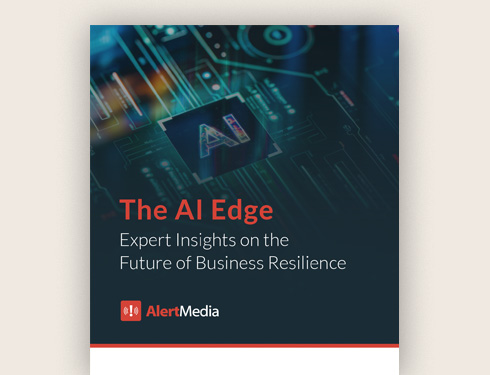AI streamlines operations—but it also brings risks. From data security to compliance, managing AI effectively is critical. Discover expert insights and key frameworks to safeguard your business.

AI Risk Management: Frameworks & Expert Insights

According to McKinsey’s 2024 survey, 78% of companies now use artificial intelligence (AI)—a trend driven by measurable advantages. The right AI tool helps teams work smarter by automating repetitive tasks, analyzing vast amounts of data in seconds, making predictions (e.g., forecasting sales or risks), and reducing errors that slow down workflows.
“AI is still a tool, and the real concern lies in who is using it, how they are using it, and how that information influences decision-making processes.”Dr. Maaz Amjad Assistant Professor, Texas Tech University
However, AI’s rapid adoption also introduces unique risks that demand proactive management. AI technologies raise concerns like data privacy risks, inaccurate reports, and built-in biases. Proactive AI risk management is essential if you want to harness AI’s potential while minimizing the risks.
Whether you’re new to AI or an experienced user, you’ll find useful insights here. We’ll also draw expert insights from our AI Edge Report to give you tips on AI risk management.
Download The AI Edge Report
What Is AI Risk?
AI risk refers to the potential negative impacts of developing and using AI systems. Due to the evolving nature of AI technology, these risks may emerge immediately or over time. AI can also evolve and adapt based on how it is trained and used, which can introduce new risks.
Common AI risks
The first step in managing AI risk is knowing what to look for. Here are some of the common AI-related risks you should be aware of.
Technical risks
Data quality, system reliability, and scalability issues have led to high-profile AI failures, posing challenges for businesses in explaining these flaws to customers or regulators. As Shane Mathew notes, “AI systems can provide results only as good as the data they are founded on.”
For example, during COVID-19, many AI tools failed to improve diagnoses because of poor training data. One model, designed to detect the virus, mistakenly learned to flag patients based on their position in scans (lying down vs. standing) rather than medical signs. Similar issues plague tools like ChatGPT: early versions used outdated data (cut off in 2021), and even updated models (trained up to 2023) lack real-time accuracy. Without rigorous data validation, AI may deliver flawed or harmful outputs.
Reputational risks
AI mistakes aren’t just embarrassing glitches—they can damage your organization’s reputation. Since 2018, AI scrutiny has skyrocketed as tech adoption has increased, with 90% of criticism emerging in just the past five years. A single high-profile mistake can trigger lasting reputational harm, especially when sensitive data is involved.
Operational risks
“There’s a tendency to think that because it’s a computer, it must always be right. But I’ve used tools where even simple errors slip through.”Shane Mathew Principal and Founder, Stone Risk Consulting
The world doesn’t stand still, and AI models can start to slip when data changes. Predictions can go off target, decisions falter, and things break down. For example, it could be a significant operational setback for a warehouse team counting on AI for planning or stock levels.
Security risks
AI systems aren’t invincible. Generative AI models are especially vulnerable to adversarial cyberattacks, where someone feeds them junk data to manipulate results. Or, bad actors might use AI tools, like a chatbot or a monitoring setup, to get confidential data. Generative AI also makes other cyberattacks, such as phishing and ransomware, faster and easier to deploy. 70% of chief information security officers (CISOs) worry that generative AI could help cyberattackers. That breach could mess with operations and cause security vulnerabilities, making insider threat management and prevention mission-critical.
Ethical and legal risks
Governmental and legal AI regulations are picking up speed. The EU AI Act and NIST’s framework set the bar for safety and ethics. Slip up, and you could face fines, lawsuits, or a PR mess. In 2024, Air Canada learned this the hard way when its chatbot gave a passenger the wrong information about bereavement fares. The airline had to pay damages after a tribunal ruled it didn’t ensure its bot’s accuracy. This example proves AI can pose ethical and legal risks for businesses.
Social and cultural risks
“Integrating AI means balancing its benefits with the continued development and use of your team’s expertise.”Karna McGarry Vice President of Managed Services, Red5 Security
AI can also affect employees and company culture in significant ways. For example, fear of job displacement by AI is a real issue. 60% of workers worry about losing jobs to AI, which can slow adoption if teams push back. Also, AI can shape how people are treated. It builds on the datasets it gets. Thus, if that data holds bias, the algorithm spreads it.
In 2023, iTutorGroup’s AI recruiting software automatically rejected female applicants older than 55 and male applicants older than 60. The U.S. Equal Employment Opportunity Commission (EEOC) filed a complaint against the company and later agreed on a $365,000 settlement.
Strategic and competitive risks
When your AI plans don’t match your business goals, it can weaken your position. According to a study, 70% of executives believe their AI strategy is not fully aligned with their business strategy. To remain competitive, tie AI efforts to your overall plan.
Financial risks
The costs of setting up AI and the uncertainty about its return on investment (ROI) are big concerns. To ensure AI pays off long-term, conduct business impact analysis, track costs, and measure ROI.
Understanding AI Risk Management
AI risk management is the process of identifying, evaluating, and managing the downsides of AI systems. It keeps the AI lifecycle on track so it delivers value without causing unintended problems. Managing risk matters given AI’s complexity, adaptability, and impact on real-world outcomes. A single mistake can ripple out to affect operations, people, or compliance. That’s why this concern is not just for the big players—businesses of all sizes, government offices, and even startups need to watch for threats. If you’re using AI for customer support, logistics, or monitoring threats, you have to manage its risks.
AI risk vs. traditional software risk
AI risk isn’t like traditional software or program risk. Regular software sticks to a clear path. You write it, it runs, and that’s that. You can usually track and sort something out if something goes wrong. AI plays by different rules. It learns from data, shifts as it goes, and can surprise you with its decisions.
That’s what sets AI apart. While traditional software might fail due to a simple coding error, AI can produce unexpected results from messy training data or struggle to keep up when patterns change. The stakes are higher, especially when handling sensitive data.
That difference shapes how AI risk management works compared to other kinds of risk management. Typical risk management relies on set steps and known issues—for an industrial plant or a network infrastructure. When planning, you must identify potential problems, such as pump failures, and develop solutions.
AI risk management, on the other hand, requires a flexible implementation approach. The system deals with evolving factors, including shifting models, new data integration, and AI compliance. Technology solutions are just one piece of the puzzle—effective AI risk management also addresses ethical concerns like fairness and trust.
The Role of AI Risk Management Frameworks
AI risk management frameworks provide a structured approach to managing risks associated with AI development and use. The frameworks function as guides for teams to identify potential risks, conduct assessments, and resolve them.
“AlertMedia's human-in-the-loop system involves ongoing model training, with analysts correcting misinterpretations and expanding the AI’s understanding of language and context. Maintaining data integrity is our primary concern for the system’s progress.”Sara Pratley Senior Vice President of Global Intelligence, AlertMedia
These frameworks establish guidelines for companies that use AI to comply with regulatory requirements, aligning with enterprise security risk management (ESRM) strategies. Remember the iTutorGroup example we shared earlier? They learned the hard way. Implementing proper risk management frameworks can identify and help mitigate issues like programming biases before legal penalties and fines become a concern.
Additionally, managing AI risk isn’t just about dodging fines but making AI work for you. Sara Pratley, the Senior Vice President of Global Intelligence at AlertMedia, says it best in The AI Edge Report: “We believe that AI can be beneficial for our functions when humans are involved.” Frameworks ensure that human oversight shapes AI, matching it to priorities like fairness or efficiency.
Top AI Risk Management Frameworks
AI risk management frameworks establish functional solutions for organizations to manage their AI systems. These frameworks allow organizations to locate potential risks and save resources. AI management frameworks also protect organizations from costly mishaps and help them maintain regulatory compliance.
Below are some widely used AI risk management frameworks:
- NIST AI RMF: Allows teams to develop trustworthy AI, providing processes to test systems and output monitoring. It also helps prevent system spread before fixes are applied.
- EU AI Act: Represents the European regulation playbook for high-risk AI activities. The framework performs safety and ethical rule enforcement mandating AI systems to fulfill legal requirements of fairness and accountability, thus preventing potential penalties and audits.
- ISO/IEC Standards: These global benchmarks are covered by ISO/IEC standards. The standards establish quality and reliability criteria that maintain AI performance stability for different applications, from customer services to threat detection, while maintaining uninterrupted operations.
- MITRE’s Sensible Regulatory Framework: Delivers functional cybersecurity methods to protect AI systems through vulnerability management and definitions of usage responsibility.
- Google’s Secure AI Framework Strengthens AI against cyber threats, offering steps to boost resilience so systems can withstand pressure and protect critical data.
These frameworks give teams the methodologies to manage AI risks effectively, covering everything from stability to ethics.
Benefits of Effective AI Risk Management
Here are some key benefits of proactive AI risk management:
“AI’s real value lies in its ability to augment and complement human capabilities in three specific ways: clarification, classification, and escalation.”Joseph Heinzen Chief Resilience Officer, WorldSafe
- Enhances security: Consider vulnerabilities like unsecured data or gaps hackers could exploit. AI risk management entails finding and fixing these vulnerabilities before they become an issue. Locking these down through converged security strategies keeps operations and sensitive information safe.
- Improves decision-making process: Removes issues like bias or bad data that can skew AI results. With risks managed, AI’s insights, such as spotting threats or planning logistics, become more precise and dependable.
- Boosts regulatory compliance: Ensures compliance with industry standards that support responsible AI, like the EU AI Act and NIST AI RMF, helping organizations avoid fines and penalties.
- Builds internal trust: When AI operates fairly, without risks like bias or errors, teams have more faith in their tools and feel good using them.
- Strengthens AI governance: They ensure policies are in place to guide ethical AI use. Organizations can prioritize accountability structures for their AI systems to align with ethical standards and regulatory requirements.
- Promotes external transparency: Shows customers and partners you’re serious about ethical AI. By safeguarding data, explaining decisions, and implementing other clear practices, you prove you’re open and accountable. In this way, you strengthen ties and reputation, reassuring stakeholders that their trust is well-placed.
NIST AI Risk Management Framework Overview
The National Institute of Standards and Technology AI Risk Management Framework, or NIST RMF, gives organizations a straightforward way to handle AI risks. NIST AI RMF is built around four primary functions:
- Govern: Sets the rules and roles needed for organizational risk management.
- Map: Identifies and evaluates AI risks by looking at them from different angles, so nothing gets missed.
- Measure: Monitors AI systems in real-time to ensure they can be trusted.
- Manage: Puts strategies in place to mitigate the identified risks and keep AI systems on the right track.
The framework also defines seven traits of trustworthy AI:
- Valid and reliable: Trustworthy AI delivers steady and accurate outputs you can count on every time.
- Safe: Protects users and operations from any kind of harm.
- Secure and resilient: Resist attacks and recover fast if something goes wrong.
- Accountable and transparent: Has a clear process that shows how things work.
- Explainable and interpretable: Its decisions make sense to people, not just machines.
- Privacy enhanced: Ensures personal data is protected, fixing privacy concerns.
- Fair with harmful bias managed: Reduces unfairness and always aims for balanced results.
Implementing AI Risk Management
Implementing AI risk management includes identifying, reducing, and monitoring risks. It’s all about making AI work properly without causing issues. Below are the steps with examples and tools to use.
1. Conduct risk assessment
Risk assessment is the first step in implementing AI risk management. Review your AI systems and usage plans for potential issues. The assessment process should detect potential risks, including bias and data security threats, which could compromise confidentiality and regulatory compliance violations.
This evaluation protocol may involve examining threat detection AI systems. Does it miss patterns? How does the system produce an excessive number of incorrect alerts? Your risk assessment will identify every problem that needs correction.
2. Develop risk mitigation strategies
Risk mitigation is addressing the problems identified in your security risk assessment. For instance, you can remove duplicate records, fix missing entries, or delete outdated data. If your AI uses customer records, you might want to replace old entries with data from recent years to keep them updated.
The right tools can also make a difference. IBM’s AI Fairness 360 toolkit checks machine learning models for bias and helps correct it. Also, Microsoft’s Fairlearn adjusts results for fairness, and Google’s What-If Tool tests how changes affect outputs.
3. Establish governance policies
“According to our official AlertMedia policy, 'The first rule of GenAI is: Human in the Loop. The second rule of GenAI is: Human in the Loop!’ In other words, the use of AI is acceptable only when the user is situationally aware and thinking critically.”Matt Ray Vice President of Security & Compliance, AlertMedia
Establish governance policies to define rules for AI use within your organization. Include clear guidelines such as “no using customer data without consent” or “explain major decisions.” For example, you might require AI systems to provide justification for significant automated decisions. Having a clear company-wide policy ensures consistency and avoids legal problems.
4. Implement security controls
This step requires you to establish security controls to protect your AI systems. Data encryption serves two purposes: it protects data from leaks and restricts model modification access to authorized personnel who can minimize mistakes. Your system must undergo testing to detect attacks from inaccurate data input and prevent improper responses to junk data. These AI security measures will help you maintain safe and reliable operations.
5. Monitor and update regularly
This final step is continuous and includes regular updates to keep your AI working correctly. Check performance by comparing predictions to actual results. Look out for errors by planning regular reviews to identify risks early. Being risk aware will help you update your strategies when new risks surface or regulations change.
Challenges in AI Risk Management
Implementing AI risk mitigation strategies is complex, and companies may face obstacles along the way. Understanding these challenges helps teams prepare and find solutions. These are some of the challenges you might face:
- Poor data quality: AI requires quality data to function well, but incomplete or inaccurate data can produce unreliable results that undermine trust in the system.
- Over-reliance on AI: Some organizations rely too much on AI without human supervision. This causes them to miss nuanced issues that AI technology alone can’t catch.
- Lack of explainability: Some AI systems don’t reveal how they make decisions, making it challenging to ensure fairness or explain outcomes to stakeholders who need clarity.
- Limited resources: Smaller organizations might struggle to keep up with risk management practices because they lack the resources to handle everything simultaneously.
- Changing regulations: Keeping up with fast-changing rules requires constant effort. Falling behind can lead to compliance issues.
Fortunately, there are ways to address these challenges. Experts suggest consistent testing and staff training to spot issues early, making the entire process practical and effective.
Want to explore this further? Check out our AI Edge Report for insights straight from the field.










